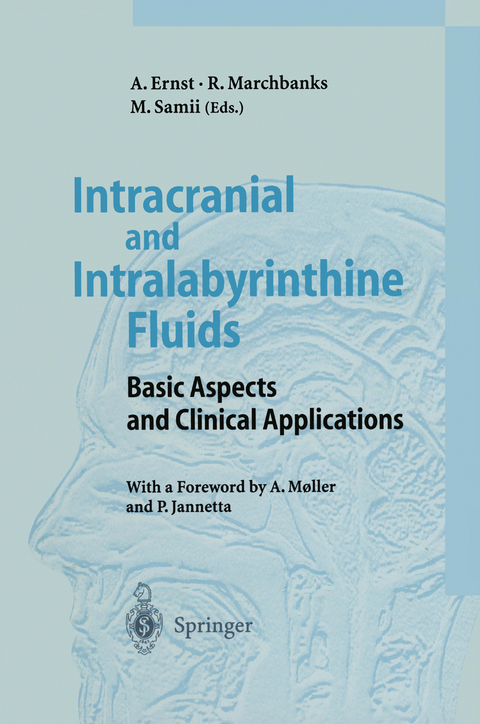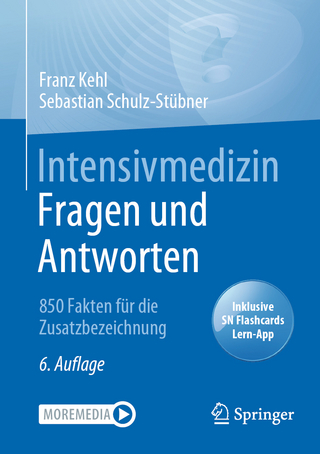
Intracranial and Intralabyrinthine Fluids
Springer Berlin (Verlag)
978-3-642-80165-5 (ISBN)
Arne Ernst studierte von 1978 bis 1984 Medizin an der Universität Halle-Wittenberg, Habilitation 1992 in Tübingen (Prof. Zrenner). Bis 1997 war er an der Medizinischen Hochschule Hannover tätig, seit 1997 ist er Direktor der HNO-Klinik im UKB.
1. Basic aspects of intracranial and intralabyrinthine fluids.- Stretch-activated channels and volume regulation in Opossum kidney cells.- Extracellular space ionic composition, volume and geometry during neuronal activity and pathological states.- Longitudinal fluid movements in the cochlea under normal and abnormal conditions.- The effect of volume regulatory mechanisms in auditory sensory cells to compensate for volume and pressure overload.- Ionic control of volume and pressure regulation in the labyrinth.- 1.1. Structural and functional aspects of the intracranial and intralabyrinthine fluid-filled compartments.- Communication routes between intracranial and intralabyrinthine fluid-filled spaces.- Hydromechanical interactions of the intracranial and intralabyrinthine fluids.- Pressure relation between the labyrinthine and intracranial fluids.- Correlation of direct and non-invasive ICP measurements in cat.- Experimental endolymphatic hydrops and inner ear pressure.- Intralabyrinthine pressure transmission of intracranial pressure in the normal guinea pig.- Hydrocephalus and the status of endolymphatic membranes in temporal bones of children.- Composition, formation and flow of intralabyrinthine fluids.- Differences in biochemical composition between perilymph, cerebrospinal fluid and blood plasma in the guinea pig.- Connections between the cerebrospinal fluid space and the lymphatic system of the head and neck in humans.- Magnetic resonance imaging of the intralabyrinthine fluids under physiological and pathological conditions.- High-resolution magnetic resonance imaging of the fine structure of the human cochlea.- Clinical significance of the large vestibular aquaeduct.- 2. Clinical applications.- 2.1. Diagnostic tools in monitoring and imaging.- Electrophysiological monitoring in neurosurgical patients with increased intracranial pressure.- Otoacoustic emissions: a new tool for monitoring intracranial pressure.- The effect of body position on transient otoacoustic emission.- Non-invasive perilymphatic pressure measurement in normal hearing subjects and in patients with Meniere's disease using the MMS-10 Tympanic Displacement Analyser.- Age-related changes in perilymphatic pressure: Preliminary results.- Diagnostics of perilymphatic hypertension.- The prevalence of perilymphatic hypertension in tinnitus patients.- Assessment of the clinical value of the Tympanic Membrane Displacement (TMD) test in children with shunted hydrocephalus.- Neuro-otological findings in raised intracranial pressure.- Papilledema in cases of acute elevated intracranial pressure.- Optic nerve changes in raised intracranial pressure.- Fluctuating hearing loss in patients with large vestibular aqueduct syndrome.- Audiologic characteristics of patients with the X-linked stapes gusher syndrome.- TMD recordings in patients with intracochlear hyper- and hypotension.- Round Window Displacement caused by altered middle ear pressure inducing impairment of bone-conduction threshold?.- 2.2. Medical and surgical management of elevated intracranial and intralabyrinthine pressure.- Pseudotumor Cerebri: Symptoms, associations, etiological considerations and therapy.- Otolith disease - experimental findings and clinical implications.- The X-recessive progressive, mixed deafness syndrome with perilymphatic gusher during stapes surgery (DFN 3).- Surgical management of stapes gusher in middle ear surgery.- Recurrent perilymphatic fistula as the initial and prime symptom of pseudotumor cerebri: Diagnosis and management with lumbarperitoneal shunt - Report of threecases.- 2.3. Round table discussion: "Surgical management of intracranial and intralabyrinthine hypertension".
| Erscheint lt. Verlag | 14.12.2011 |
|---|---|
| Vorwort | A. Moller, P. Jannetta |
| Zusatzinfo | XIV, 300 p. |
| Verlagsort | Berlin |
| Sprache | englisch |
| Maße | 155 x 235 mm |
| Gewicht | 486 g |
| Themenwelt | Medizinische Fachgebiete ► Chirurgie ► Neurochirurgie |
| Medizin / Pharmazie ► Medizinische Fachgebiete ► HNO-Heilkunde | |
| Medizin / Pharmazie ► Medizinische Fachgebiete ► Neurologie | |
| Schlagworte | clinical application • Diagnostics • Ear • Endoscopy • Head • hearing • Hydrocephalus • Intracranial pressure • Magnetic Resonance Imaging (MRI) • Neuronavigation • Regulation • Surgery • therapy • Tinnitus • Tumor |
| ISBN-10 | 3-642-80165-X / 364280165X |
| ISBN-13 | 978-3-642-80165-5 / 9783642801655 |
| Zustand | Neuware |
| Informationen gemäß Produktsicherheitsverordnung (GPSR) | |
| Haben Sie eine Frage zum Produkt? |
aus dem Bereich


